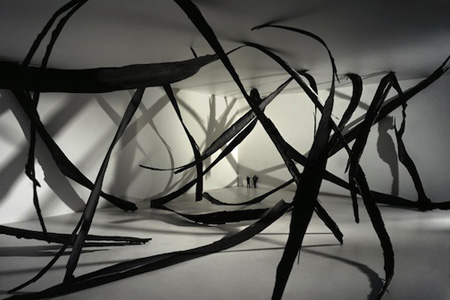
Continuing through August 27, 2011
Although the idea of creating setups to be photographed can be seen as nothing more than the traditional studio practice of arranging vases, blocks, and tablecloths for Drawing 101, it has led to works that combine the still life genre’s formal beauty with social commentary or epistemological inquiry. Los Angeles photographer David DiMichele is showing a dozen large-format photographs under the title, “Pseudodocumentation,” thereby emphasizing its falseness or artificiality, in contradistinction to the “objective” journalistic photo. DiMichele ostensibly depicts the immense interior spaces of contemporary art museums, their rectangular walls covered and pierced by various artistic installations on a colossal scale. So convincingly done are these works, made from studio setups, that they seem credible — contemporary versions, with their tiny figures, of owl-haunted Romantic ruins or endless crepuscular shorelines with their tiny human observers. But if they inspire delight they are also witty commentaries on contemporary art, with its “mountains of broken glass, treacherous gashes cut into the floor, giant hoses snaking around columns,” conventions of exhibiting and documentation, and how art consumers take these in, i.e., usually through printed photographs or via jpegs, onscreen.
While conceptual artists, land artists, and process artists employed deadpan photographs to document their interventions and actions, DiMichele’s photos, paradoxically, are aesthetically satisfying enough to pass muster with traditionalists. The black whorls in “Pseudodocumentation: Bark Gestures” menace tiny viewers in a corner, but make for, with their shadows, a fine calligraphic painting. The swirling tubing of “Pseudodocumentation: Apollonian and Dionysian” snakes through an Ionic-columned courtyard, making for a fine object lesson in the classical and romantic sensibilities. The Tetris-shaped excavations into museum floors, wall and ceilings in “Pseudodocumentation: Holes and Light” transform Modernist abstraction into a grotto and labyrinth of almost-signifiers.
“Pseudodocumentation: Salt and Asphalt” covers a series of galleries with mountains of black and white. Anyone versed in contemporary art will enjoy the show’s wit and elegance, and perhaps be reminded of William T. Wiley’s “E-Stream Art,” a semi-abstract watercolor painting of a plowed landscape canceled by a corner-to-corner X (filled with water). It was done when earth artists were using bulldozers to cancel huge swaths of land. Wiley said, “I was thinking ... ’that’s too disruptive out there.’ Better to do Earth Art here in a little watercolor and not mess up the landscape. I could explore all the ideas that they’re exploring and cause a lot less damage.” That is not to suggest that DiMichele’s rhetoric here is particularly environmental; perhaps some disruption of a pristine museum gallery might be worth the effort.
